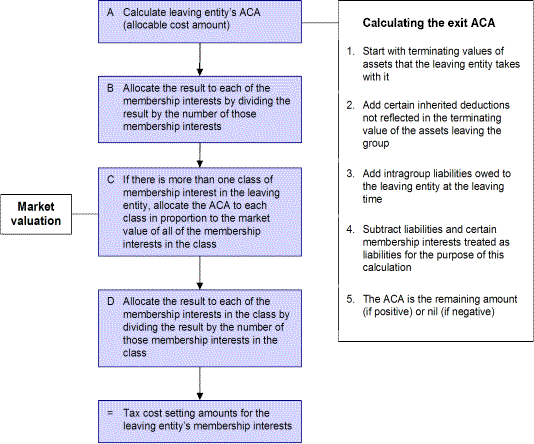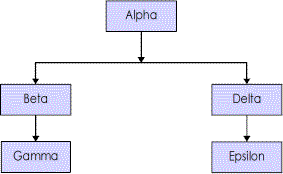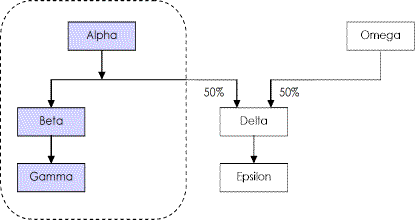Consolidation Reference Manual
You can still refer to the Consolidation reference manual for consolidation information that has not been impacted by changes in the legislation.
C2 Assets
C2-2 High-level worked example
Cost setting on exit
C2-2-210 The cost setting process on exit
Description
This high-level example shows how the cost setting rules apply when a subsidiary member of a consolidated group leaves the group. The process is shown in the figure below. Some steps in the process are expanded on in worked examples included in this section of the Reference Manual.
Figure 1: Cost setting process on exit

Commentary
When a subsidiary member (the leaving entity) leaves a consolidated group, the head company recognises for tax purposes, just before the leaving time, the membership interests in the leaving entity. These membership interests are not recognised while the entity is a member of the group. The cost for the membership interests equals the head company's cost for the net assets in the leaving entity just before the leaving time. This preserves the alignment between the costs for membership interests in the entity and its assets. → 'Treatment of assets', C2-1
Example
Facts
Alpha consolidated group, consisting of Alpha as the head company and Beta and Gamma as subsidiary members, is formed on 1 July 2002. On 30 June 2009, Alpha acquires 100% of Delta (and its wholly-owned subsidiary Epsilon) by paying $10,000 for 1,000 shares, and the consolidated group is structured as follows:
Figure 2: Alpha consolidated group

The financial position of Delta and Epsilon on joining the group is shown in tables 1 and 2.
| Book value | Market value | Cost base | Terminating value | |
|---|---|---|---|---|
| Assets | ||||
| Cash | $1,000 | $1,000 | $1,000 | $1,000 |
| Trading stock | $2,000 | $2,000 | $2,000 | $2,000 |
| Land 1 | $3,000 | $3,000 | $3,000 | $3,000 |
| Shares in Epsilon | $4,000 | $4,000 | $4,000 | $4,000 |
| Liabilities | $0 | $0 | ||
| Equity | ||||
| 500 class A shares | $5,000 | $5,000 | $5,000 | |
| 500 class B shares | $5,000 | $5,000 | $5,000 | |
| Book value | Market value | Cost base | Terminating value | |
|---|---|---|---|---|
| Assets | ||||
| Cash | $1,000 | $1,000 | $1,000 | $1,000 |
| Land 2 | $2,000 | $2,000 | $2,000 | $2,000 |
| Land 3 | $1,000 | $1,000 | $1,000 | $1,000 |
| Liabilities | $0 | $0 | ||
| Equity | ||||
| 100 shares | $4,000 | $4,000 | $4,000 | |
During the 2009-10 income year:
- •
- Delta and Epsilon do not trade
- •
- Delta loans $1,000 to Beta
- •
- Delta borrows $2,000 from Omega on 1 July 2009 (immediately after joining Alpha's consolidated group) and incurs $200 borrowing expenses, and
- •
- Gamma transfers an asset (Land 4) to Delta on 20 August 2009.
On 30 June 2010, Alpha sells 50% of its investment in Delta to Omega, which pays $14.80 for each of 250 Class A shares and $12.80 for each of 250 Class B shares. After the sale, Delta is 50% owned by Alpha and 50% by Omega. As Delta is no longer a wholly-owned subsidiary of Alpha it does not meet the criteria to be a member of the consolidated group. Therefore, Delta leaves the consolidated group on 30 June 2010, along with its wholly-owned subsidiary Epsilon, which (because of the part sale of its sole parent) is no longer wholly owned by the group.
Figure 3: Alpha consolidated group after part sale of Delta

The financial position of Delta and Epsilon at the time of Delta's part sale is shown in tables 3 and 4.
| Book value | Market value | Cost base | Terminating value | |
|---|---|---|---|---|
| Assets | ||||
| Cash | $1,800 | $1,800 | $1,800 | $1,800 |
| Receivables | $1,000 | $1,000 | - | - |
| Trading stock | $2,000 | $2,000 | $2,000 | $2,000 |
| Land 1 | $3,000 | $5,000 | $3,000 | $3,000 |
| Land 4 | $2,000 | $2,000 | $2,000 | $2,000 |
| Shares in Epsilon | $4,000 | $4,000 | $4,000 | $4,000 |
| Liabilities | $2,000 | $2,000 | ||
| Equity | ||||
| 500 class A shares | $5,900 | $7,400 | $5,000 | |
| 500 class B shares | $5,900 | $6,400 | $5,000 | |
| Book value | Market value | Cost base | Terminating value | |
|---|---|---|---|---|
| Assets | ||||
| Cash | $1,000 | $1,000 | $1,000 | $1,000 |
| Land 2 | $2,000 | $2,000 | $2,000 | $2,000 |
| Land 3 | $1,000 | $1,000 | $1,000 | $1,000 |
| Liabilities | $0 | $0 | $0 | |
| Equity | ||||
| 100 shares | $4,000 | $4,000 | $4,000 | |
Order of application of cost setting
The cost of the membership interests in each of the leaving subsidiaries must be worked out on a 'bottom up' basis, as the membership interests in the lower level entity (which represent an asset of the higher level entity) must be given a cost which is used in turn to calculate the cost of membership interests in the higher level entity → section 711-55, Income Tax Assessment Act 1997 (ITAA 1997) and Explanatory Memorandum to New Business Tax System (Consolidation) Bill No. 1, paragraph 5.142. Therefore, Alpha must first apply the cost setting rules to Epsilon, before applying them to Delta.
Setting the tax costs of membership interests in Epsilon
A: Calculate exit ACA for Epsilon
ACA step 1: ACA step 1: Add up the terminating values of assets in Epsilon just before the leaving time.
| Terminating value | |
|---|---|
| Cash | $1,000 |
| Land 2 | $2,000 |
| Land 3 | $1,000 |
| $ 4,000 |
ACA step 2: Add certain inherited deductions
As Epsilon does not inherit any deduction from Alpha, no amount is added.
ACA step 3: Add intragroup liabilities owed to Epsilon
As members do not owe any liability to Epsilon, no amount is added.
ACA step 4: Subtract liabilities of Epsilon
As Epsilon has no liability, no amount is subtracted.
Exit ACA Step 5
The ACA is $4,000.
B: Apportion ACA to each class of membership interest
There is only one class of membership interests in Epsilon.
C: Divide ACA by number of membership interests in each class
The tax cost for each share in Epsilon is calculated as:
($4,000 / 100 shares) = $40 per share
Setting tax costs of membership interests in Delta
A: Calculate Delta's exit ACA
ACA step 1: Add up the terminating values of assets in Delta just before the leaving time.
Delta has five assets just before the leaving time (table 6).
| Terminating value | |
|---|---|
| Cash | $1,800 |
| Trading stock | $2,000 |
| Land 1 | $3,000 |
| Land 4 | $2,000 |
| Shares in Epsilon | $4,000 |
| $ 12,800 |
Note : the receivables of $1,000 is an intragroup debt and is not recognised within a consolidated group.
ACA step 2: Add certain inherited deductions
The borrowing expenditure of $200 incurred by Delta before the leaving time is allowable to the head company Alpha as an income tax deduction apportioned over five years; that is, $40 per year. Alpha claims $40 for the income year ended 30 June 2010, and the remaining $160 of borrowing expenses as yet unclaimed by Alpha becomes available to Delta on leaving the group to be claimed as a tax deduction over the remaining four years.
The step 2 amount is worked out by multiplying all the deductions covered by subsection 711-35(2) by the corporate tax rate. [F1]
→ subsection 711-35(1), ITAA 1997
The deductions included in this step are deductions to which the leaving entity becomes entitled under section 701-40 of the ITAA 1997 as a result of it ceasing to be a subsidiary member of the group, other than a deduction for expenditure:
- •
- that is, forms part of or reduces, the cost of an asset that becomes an asset of the leaving entity because subsection 701-1(1) (the single entity rule) ceases to apply, or
- •
- to which section 110-40 of the ITAA 1997 (expenditure on assets acquired before 7.30 pm on 13 May 1997) applies.
→ subsection 711-35(2)
Therefore, the step 2 amount calculation is:
$160 x 30% = $48
This is then added to the step 1 amount of $12,800 to give a result of $12,848 after the application of step 2
ACA step 3: Add intragroup liabilities owed to Delta
The intragroup liability of $1,000 owed to Delta is not recognised for income tax purposes while Delta is a member of the group. In this step, the liability is identified and its market value of $1,000 is added to the result of step 2:
$12,848 + $1,000 = $13,848
ACA step 4: Subtract liabilities of Delta
Delta has a $2,000 liability owed to an external party. The amount of the liability is subtracted from the result of step 3:
$13,848 - $2,000 = $11,848
Exit ACA Step 5
The ACA is $11,848.
B: Apportion ACA to each class of membership interest
| Market value | Proportion to the market values | ACA | Apportionment | |
|---|---|---|---|---|
| Class A | $7,400 | $7,400 / ($7,400 + $6,400) | x $11,848 | = $6,353.28 |
| Class B | $6,400 | $6,400 / ($7,400 + $6,400) | x $11,848 | = $5,494.72 |
C: Divide ACA by number of membership interests in each class
The tax cost for class A shares is calculated as:
($6,353.28 / 500 shares) = $12.71 per share
The tax cost for class B shares is calculated as:
($5,494.72 / 500 shares) = $10.99 per share
The head company Alpha's capital gains from the sale of Delta shares are shown in table 8.
| Proceeds - cost base | Number of shares sold | Total capital gains from the sale | ||
|---|---|---|---|---|
| Class A shares | $14.80 - $12.71 | = $2.09 | x 250 shares | = $522.50 |
| Class B shares | $12.80 - $10.99 | = $1.81 | x 250 shares | = $452.50 |
| $ 975.00 | ||||
References
Income Tax Assessment Act 1997 , section 701-1 ; as amended by:
- •
- New Business Tax System (Consolidation) Act (No. 1) 2002 (No. 68 of 2002), Schedule 1
- •
- Tax Laws Amendment (2007 Measures No. 4) Act 2007 (No. 143 of 2007), Schedule 1
Income Tax Assessment Act 1997 , section 701-40 ; as amended by:
- •
- New Business Tax System (Consolidation) Act (No. 1) 2002 (No. 68 of 2002), Schedule 1
- •
- New Business Tax System (Consolidation and Other Measures) Act (No. 1) 2002 (No. 117 of 2002), Schedule 11
Income Tax Assessment Act 1997 , section 711-20 ; as amended by:
- •
- New Business Tax System (Consolidation) Act (No. 1) 2002 (No. 68 of 2002), Schedule 1
- •
- New Business Tax System (Consolidation, Value Shifting, Demergers and Other Measures) Act 2002 (No. 90 of 2002), Schedule 2
- •
- New Business Tax System (Consolidation and Other Measures) Act 2003 (No. 16 of 2003), Schedule 21
- •
- Tax Laws Amendment (2010 Measures No. 1) Act 2010 (No. 56 of 2010), Schedule 5, Part 7- Division 1
Income Tax Assessment Act 1997 , section 711-25 ; as amended by:
- •
- New Business Tax System (Consolidation) Act (No. 1) 2002 (No. 68 of 2002), Schedule 1
- •
- Tax Laws Amendment (2004 Measures No. 2) Act 2004 (No. 83 of 2004), Schedule 2
- •
- Tax Laws Amendment (2010 Measures No. 1) Act 2010 (No. 56 of 2010), Schedule 5, Part 7- Division 1
Income Tax Assessment Act 1997 , section 711-35 ; as amended by:
- •
- New Business Tax System (Consolidation) Act (No. 1) 2002 (No. 68 of 2002), Schedule 1
- •
- Tax Laws Amendment (2010 Measures No. 1) Act 2010 (No. 56 of 2010), Schedule 5, Part 7, Division 1 and Part 9
Income Tax Assessment Act 1997 , section 711-45 ; as amended by:
- •
- New Business Tax System (Consolidation) Act (No. 1) 2002 (No. 68 of 2002), Schedule 1
- •
- New Business Tax System (Consolidation, Value Shifting, Demergers and Other Measures) Act 2002 (No. 90 of 2002), Schedule 2
- •
- Tax Laws Amendment (2004 Measures No. 6) Act 2005 (No. 23 of 2005), Schedule 1
- •
- Tax Laws Amendment (2004 Measures No. 7) Act 2005 (No. 41 of 2005), Schedule 6
- •
- Financial Sector Legislation Amendment (Restructures) Act 2007 (No. 117 of 2007), Schedule 3
- •
- Tax Laws Amendment (2010 Measures No. 1) Act 2010 (No. 56 of 2010), Schedule 5, Parts 7 , 8 , 9 , and 20.
Income Tax Assessment Act 1997 , sections 711-40 and 711-55 ; as amended by New Business Tax System (Consolidation) Act (No. 1) 2002 (No. 68 of 2002), Schedule 1
Income Tax (Transitional Provisions) Act 1997 , sections 701-1 and 701-40 ; as amended by New Business Tax System (Consolidation, Value Shifting, Demergers and Other Measures) Act 2002 (No. 90 of 2002), Schedule 7
Income Tax Assessment Act 1997 , section 110-40
Explanatory Memorandum to New Business Tax System (Consolidation) Bill No. 1, paragraph 5.142
Explanatory Memorandum to Tax Laws Amendment (2010 Measures No. 1) Bill 2010, Chapter 5
History
Revision History
Section C2-2-210 first published (excluding drafts) 2 December 2002.
Further revisions are described below.
| Date | Amendment | Reason |
|---|---|---|
| 14.7.04 | Note on proposed changes to consolidation rules, p. 2. | Proposed legislative amendments. |
| 26.10.05 | Removal of note on proposed change to rules. | Legislative amendments. |
| 26.6.07 | Note on proposed changes to clarify both the valuation of liabilities and the accounting principles to be used, p. 8. | Reflect announcement on 8 May 2007 by Assistant Treasurer in media release no. 50. |
| 6.5.11 | 'certain membership interests' changed to 'certain interests', at step 4 in calculating the exit ACA in figure 1.
Changes to the example to reflect modifications to the calculation of the step 2 amount and to clarify the facts. |
Removal of note on proposed changes to clarify both the valuation of liabilities and the accounting principles to be used. |
Current at 6 May 2011
For exits that occurred before 10 February 2010, the step 2 amount is worked out using the formula: Owned deductions + (Acquired deductions x Corporate tax rate). Acquired deductions are those that were acquired deductions at step 7 of the entry ACA when an entity became a subsidiary member of a consolidated group ' Adjustment for certain inherited deductions (ACA step 7), C2-4-340 . Owned deductions are deductions that are not acquired deductions.
